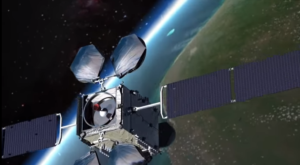Evolution of Commercial Satellite Technology Improves Readiness

With Special Operations troops deployed in as many as 100 spots around the world, and with the recent focus of the U.S. Army on quick-reaction capability, it’s clear that readiness is the prime driver of the military today.
Those troops and others need to be able to communicate and to send and receive the latest in intelligence, surveillance and reconnaissance information, a lesson learned from more than a decade of U.S. military campaigns in the Middle East and Southwest Asia.
As a result, the U.S. Department of Defense is beginning to take a larger role in seeking out commercial technology and innovation that could be used in space, both to meet threats in an increasingly uncertain environment there and to meet new challenges on the ground. The Pentagon is also working to change its acquisition approach to better take advantage of new commercial technologies as they become available.
In a recent speech in Silicon Valley’s high-tech hub, Defense Secretary Ashton Carter said the DoD was going to spend $22 billion on space projects in 2017. He also announced the formation of a DoD Innovation Advisory Board, headed by Eric Schmidt, executive chairman of Alphabet, Google’s parent company.
The upcoming DoD study of the Analysis of Alternatives (AoA) for wideband satellite communications gives the Pentagon an opportunity to look to commercial companies for the best ways to support the warfighter with the latest in space technology. By involving commercial companies, the DoD will be able to see how advances in commercial satellites can help the United States maintain its superiority in space.
Intelsat has long been a leader in launching and operating continuously improved spacecraft, the latest example of which is the Intelsat EpicNG platform. Our first EpicNG satellite, Intelsat 29e, reached orbit in January and a second EpicNG will be launched later this year. A key feature of the EpicNG spacecraft is the digital payload technology, first developed by The Boeing Company for use on the DoD’s WGS satellites. It is the most advanced digital payload commercially available.
While this understanding might seem far afield for warfighters on the ground, it’s important for units supporting them.
Intelsat’s next generation EpicNG satellite fleet combines wide beams and spot beams with frequency reuse technology to meet the growing demand for broadband connectivity worldwide. Benefits include:
- Inherent Anti-jamming – Intelsat EpicNG beams are significantly smaller than wide beams covering a broad geographic area, thereby limiting jamming opportunities. With the onboard digital switch, jammers can be detected and stopped at the satellite, preventing them from polluting the satellite’s downlink. Also, desired carriers can be re-tuned to avoid the jammer and the onboard digital payload re-configured so the desired carrier still arrives at its destination at the original downlink frequency.
- Additional Layer of Protection – IGC has participated in tests led by the U.S. Air Force that validated the protected tactical waveform (PTW) modem performance over the Intelsat EpicNG PTW will provide resilient, cost effective, protected communications in multiple frequency bands.
- Smaller Ground Terminals –Higher power due to the smaller, more focused spot beams of the Intelsat EpicNG platform will allow for much smaller and more affordable antennas on the ground. This lower cost has unleashed a wave of innovation in the market, with a prime example being smaller, cheaper and easier to operate antennas that are flat and automatically lock onto satellites. Intelsat has partnered with two flat-panel antenna developers, Kymeta and Phasor, to design and manufacture these terminals.
The initial Intelsat EpicNG satellites are a first step towards software-defined satellites, which will deliver immense benefits for customers. The move to fully reconfigurable satellite payloads on orbit offers the possibility that satellite design and launch can be standardized and streamlined.
This will result in increased flexibility and substantial cost savings. Satellites are typically designed and custom built for a specific orbital location and beam coverage. Software-defined satellites can all be built the same and configured on orbit. Manufacturing costs will be significantly lower, which opens the door for building quickly deployable spares.
Other features we expect to see in later HTS spacecraft include:
- Flexible Power Allocation — For each high power amplifier on the satellite, Intelsat will be able to direct portions of the amplifier’s output to different beams, as needed. For each high power amplifier on an HTS satellite, the digital payload can change the output to different beams based on the amount of signal traffic.
- Beam Forming – Operators on the ground will be able to define and implement customized satellite coverage beams to provide more capacity to a specific area as operational needs or conditions change. This will be particularly important in military operations.
Another major technology development involves Intelsat’s partnership with OneWeb, which is developing a constellation of up to 720 satellites in low-earth orbit (LEO) by 2019 using the Ku-band. OneWeb satellites would provide global connections to ground antennas that would serve as local hotspots for 3G and 4G cellular service.
These hotspots can make rapidly deployed troops more effective and can make their jobs easier and safer. For example, the LEO satellites will complement our GEO broadcast capabilities with LEO high elevation angles for select situations where GEO signals may be blocked.
Our fleet and capabilities are evolving with the kinds of features and functionality that the U.S. military needs to maintain American superiority in space. By including commercial companies in the AoA process for wideband communications, the DoD will be able to better define how the satellite ecosystem can best serve war fighter needs.
The Pentagon can also take advantage of speed with which commercial companies can get new technologies into space. Government planners will better understand how to improve communications resiliency by spreading Satcom across a range of commercial spacecraft in LEO and GEO offering pole-to-pole coverage.
That coverage means improved readiness, meeting the needs of American and allied troops around the world.






















